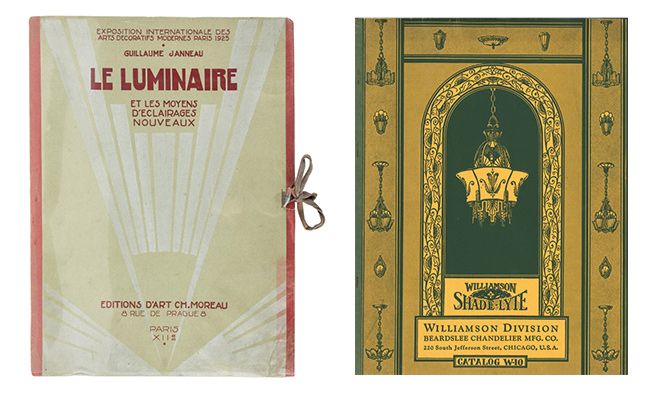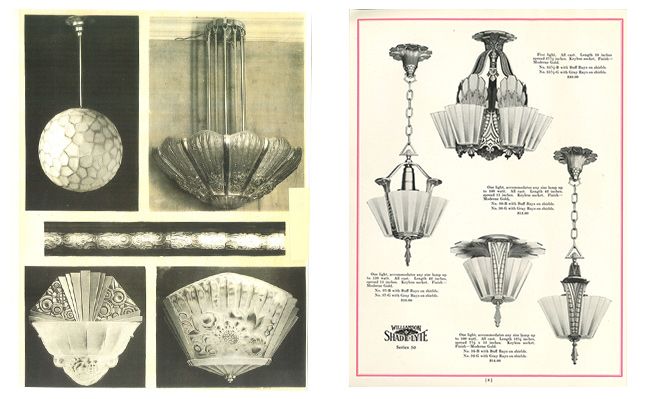We're committed to preserving the unique character of each antique light, which means developing a deep understanding of the history behind each era and aesthetic. Learn more about how this iconic style grew in popularity with the history of Art Deco lighting below, and shop our expansive collection of restored antique Art Deco lighting.
Characterized by symmetrical patterns and geometric details, Art Deco lighting employs a variety of finishes to create a distinctive and futuristic effect. You'll find tiered, elongated architectural forms featuring everything from skyscraper shades to stepped finials. While Art Deco lighting was typical in commercial and municipal structures in its day, these impressive fixtures make great focal points for today’s homes of any style.

Left: Le Luminaire catalog from the 1925 Paris Exposition. Right: Williamson Shade-Lyte catalog by Beardslee Chandelier Manufacturing Co. from 1930.
Ornate details reigned supreme in the early 1900s
At the turn of the 20th century, the ornate style of Classical Revival lighting was at the height of popularity. These lights featured highly decorative details inspired by the glamour of 17th century France, often highlighting ancient motifs with filigree or acanthus leaf designs.
The early 20th century also saw the transition from gas-powered to electric lighting, which resulted in electric light fixtures with exposed bulb designs. This allowed people to show off their new electric fixtures and optimize light output, as the early electric bulbs were dim by today's standards.
Lighting design underwent a transformation in aesthetic and style from the 1920s through the 1930s. Evolving design sensibilities and the rise of electric lights contributed to the streamlined yet whimsical style we now associate with Art Deco lighting.

Left: Art Deco-style lighting featured in the 1925 Le Luminaire catalog. Right: Popular Art Deco-era styles from the 1930 Williamson Shade-Lyte catalog.
The shift toward streamlined elegance
Lighting historians trace the beginning of the Art Deco movement to a decorative arts fair held at the Grand Palais in Paris in 1925. Catalogs in our archive and information from the expo feature some of the first sightings of more streamlined, geometric-inspired light fixtures.
As the gathering place for emerging and high-end artisans, the expo showcased a variety of designs throughout the decorative arts world, from lighting to furniture. The official name of the event was the International Exhibition of Modern Decorative and Industrial Arts, which is how the name for the movement, "Art Deco," was derived years later.

Identifying key Art Deco style elements
In the 1920s, lighting manufacturers developed new capabilities for intricate detail work with high-quality materials. Plus, as technology advanced, electric light bulbs became much brighter, creating the need for shades for more natural, diffused light. All of this contributed to the Art Deco movement in lighting, which features a range of subsets in style and design.
- Glass panels obscuring the light bulb
- Faceted forms with stepped fan details
- Cascading tiered silhouettes, large-scale fixtures
- Slipper-style shades, ornately cast etched glass detailing

Subsets of the Art Deco aesthetic
High Art Deco: Most of the light fixtures seen at the 1925 Paris expo fall under this category.
- Defined by the use of high-quality materials and intricate manufacturing.
- Often featured geometric or botanical motifs combined with streamlined silhouettes.
- Oversized designs ideal for hotels, theaters, and commercial spaces with grand foyers.
Streamline: Many of the "stereotypical" Art Deco lights would be considered more streamlined; these designs emerged in the 1930s-1940s.
- Aerodynamic modern silhouettes with minimal detailing and clean lines.
- Standard scale ideal for the everyday home.
Greco-Deco: A combination of Art Deco design sensibility with the Grecian motifs found in more Classical Revival styles.
Art Deco popularity in the Depression era
By the 1930s, Art Deco styles were in full swing as American designers started to look toward French and European lighting from the Paris exposition. Simplistic, streamlined designs became more popular later in the 1930s and early 40s. When the USA entered World War II, wartime restrictions on manufacturing and metal materials meant that many light fixtures featured more glass components and less detail. This focus on utility and function eventually gave way to the industrial movement in the 1940s.
Our antique Art Deco lighting collection
Recently, our buyers came across a unique collection of Art Deco lighting from the 1930s. Many of these fixtures feature original finishes and were restored by our team when necessary and fully rewired. You'll find many High Art Deco designs with lots of detailing, along with some Streamline fixture options.
We carefully source each antique light in our assortment, from one-of-a-kind discoveries to this collection of Art Deco lighting. Learn more about Antique Lighting Styles and shop our newly restored Art Deco lighting today.







